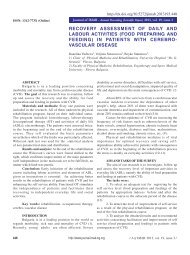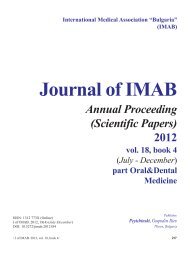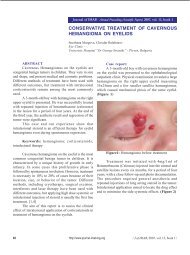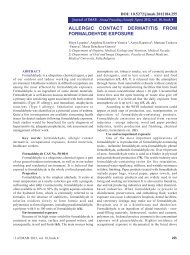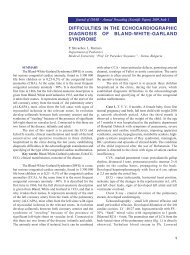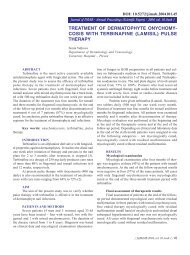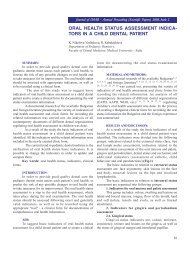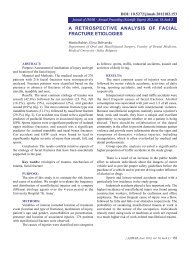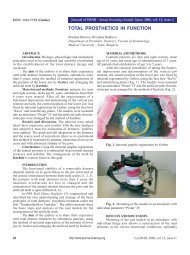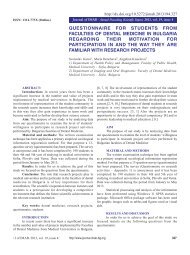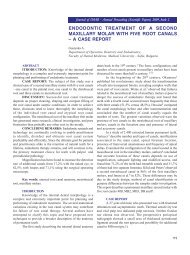Download FULL TEXT - Journal of IMAB
Download FULL TEXT - Journal of IMAB
Download FULL TEXT - Journal of IMAB
You also want an ePaper? Increase the reach of your titles
YUMPU automatically turns print PDFs into web optimized ePapers that Google loves.
<strong>Journal</strong> <strong>of</strong> <strong>IMAB</strong> - Annual Proceeding (Scientific Papers) 2011, vol. 17, book 2<br />
TRIPLE ACTION PALATE EXPANDER<br />
Svetlana Yordanova, Miroslava Yordanova, Stoyan Yovchev<br />
Department <strong>of</strong> Orthodontics, Faculty <strong>of</strong> Dentistry, Medical University, Plovdiv,<br />
Bulgaria<br />
ABSTRACT<br />
Malocclusion correction essentially involves expansion<br />
<strong>of</strong> the maxilla, protrusion <strong>of</strong> anterior teeth and opening the<br />
bite. Expansion is <strong>of</strong>ten the stage preceding the treatment with<br />
fixed appliances. The elevation <strong>of</strong> the occlusion using<br />
accomplished with different devices (bite planes -fixed or<br />
removable, composite material on the occlusall surface <strong>of</strong><br />
molars) carries the risk <strong>of</strong> breaking or debonding them.<br />
The present article proposes an expanding appliance<br />
with triple action as a therapeutic means <strong>of</strong> choice in an<br />
orthodontic treatment with fixed appliances. The expander can<br />
simultaneously be used to protrude upper teeth, to expand the<br />
upper jaw and disarticulate the occlusion. It can be easily<br />
fabricated in clinical conditions, causes no discomfort and<br />
does not hamper oral hygiene because it can be removed and<br />
cleaned.<br />
Design <strong>of</strong> expander:<br />
1.Expansion screw and connecting arms (fig.1-1)<br />
2.Expander fixators to the molar bands (fig1-2).<br />
3.Springs for protrusion (fig. 1-3).<br />
4.Orthodontic bands for molars (fig.1-4).<br />
5.Occlusal coverage <strong>of</strong> acrylic for premolars and<br />
canines (fig.2-1)<br />
Key words: expansion, expanders (fixed and<br />
removable), deep bite correction, bite planes<br />
INTRODUCTION<br />
Correction <strong>of</strong> complex malocclusions necessarily<br />
includes in the treatment plan procedures such as jaw<br />
expansion, anterior teeth protrusion and opening the bite.<br />
These can be achieved in a mixed dentition by using various<br />
functional devices (1). Practice has taught that in a permanent<br />
dentition expansion and protrusion most <strong>of</strong>ten precede<br />
treatment with fixed appliance. Deep bites ( 2) usually do not<br />
allow brackets to be bonded on the vestibular surface <strong>of</strong><br />
lower front teeth if the dental arches have not been<br />
disarticulated. There are two solutions <strong>of</strong> this problem. Most<br />
<strong>of</strong>ten occlusion is elevated by applying composite material<br />
on the occlusal surface <strong>of</strong> molars . Another approach to the<br />
problem could be to fix a bite plane on the lingual surface <strong>of</strong><br />
the upper central incisors (3, 4, 5). There are two main<br />
disadvantages <strong>of</strong> these two approaches: debonding and<br />
braking <strong>of</strong> the composit materials or the bite planes, one<br />
reason being that patients bite on them.<br />
Use <strong>of</strong> fixed expanders are associated with another<br />
type <strong>of</strong> disadvantages (1, 6). They tends to cause a definitive<br />
masticatory, speaking and hygienic discomfort in patients.<br />
Aim: We propose a removable expander with<br />
protruding, expanding and disarticulating action and a method<br />
for its attachment to the upper jaw.<br />
Figure 1. Components <strong>of</strong> the expander (1 – expansion<br />
screw and connecting arms; 2 – expander fixators to the molar<br />
bands; 3 - protrusion springs; 4- orthodontic molar bands)<br />
Mechanism <strong>of</strong> action <strong>of</strong> the expander<br />
1. The expanding action <strong>of</strong> this expander is based on<br />
well known biomechanical principles related to the lingual<br />
plate effect (7). What makes it particularly convenient for an<br />
orthodontist is that the appliance utilises a common, rather<br />
than special, expansion screw. The screw expansion action is<br />
transmitted to the teeth via the occlusal coverage <strong>of</strong> acrylic<br />
for premolars and canines with the help <strong>of</strong> the connecting<br />
arms (Fig. 2).<br />
2. Elevation and disarticulation is achieved through<br />
occlusal coverage <strong>of</strong> acrylic which extends to half <strong>of</strong> the<br />
occlusal surface <strong>of</strong> premolars and the lingual surface <strong>of</strong><br />
canines. The degree <strong>of</strong> elevation and disarticulation is<br />
determined by taking a construction bite.<br />
126 / J<strong>of</strong><strong>IMAB</strong>; Issue: 2011, vol. 17, book 2 /
The screw is connected to the orthodontic bands<br />
through two connecting arms made <strong>of</strong> 0.9 mm orthodontic<br />
wire (Fig. 2)<br />
Figure 2. View <strong>of</strong> the expander (1 – occlusal coverage<br />
<strong>of</strong> acrylic for premolars and canines; 2 – connecting arms).<br />
The place <strong>of</strong> the screw is determined individually by<br />
well known methods (7). Isolating and elevating foil <strong>of</strong> 0.5<br />
mm is placed between the cast model and the screw to secure<br />
the palatal gingiva from traumas during use <strong>of</strong> the expander<br />
(Fig. 3-1).<br />
Figure 3. Design <strong>of</strong> the expander – close view (1 -<br />
isolating foil; 2 –L-shaped expander fixators to the molar<br />
bands)<br />
3. The protrusion arms are made <strong>of</strong> orthodontic wire<br />
0.8 mm in diameter. They pass along the lingual surface <strong>of</strong><br />
the upper incisors close to the gingival edge. The end <strong>of</strong> the<br />
arms is firmly retained into the occlusal coverage <strong>of</strong> acrylic.<br />
The expander has two fixators made <strong>of</strong> orthodontic<br />
wire 0.8 mm in diameter. One <strong>of</strong> their ends is attached to the<br />
plastic bite planes, while the other passes along the lingual<br />
wings <strong>of</strong> the molar bands. The distal end <strong>of</strong> the fixator in a<br />
L-shaped bend is inserted into the distal wing <strong>of</strong> the molar<br />
band. The distal wing is shaped like a hole. The length <strong>of</strong> the<br />
L-shaped arm is adjusted individually but it should not touch<br />
the palatal gingiva (Fig. 3).<br />
Fabrication <strong>of</strong> the expander<br />
1. Take an impression from the upper jaw together with<br />
the adjusted molar bands (not yet bonded).<br />
2. The molar bands are then removed from the teeth<br />
and placed into the impression.<br />
3. An impression is taken <strong>of</strong> the lower jaw and the<br />
construction bite is determined.<br />
4. Plaster models are made and incorporated in an<br />
occluder.<br />
5. The wire components are manufactured.<br />
6. The screw place is determined and the screw is<br />
attached to the model together with the wire elements and the<br />
isolating foil by sticky wax.<br />
7. The occlusal coverage <strong>of</strong> acrylic for premolars and<br />
canines and the acrylic covering the screw are shaped in the<br />
desired form using photopolymering resin (8).<br />
8. The expander plastic is polymerised using a photo<br />
lamp.<br />
9. The expander is cleaned, polished and adjusted on<br />
the model. In the patient’s mouth, cement first the molar bands<br />
and then adjust the appliance.<br />
CONCLUSIONS<br />
The proposed expander with triple action has the<br />
following advantages:<br />
1. It can simultaneously expand the maxilla, protrude<br />
the anterior teeth and disarticulate the bite.<br />
2. It does not cause discomfort.<br />
3. It can be applied along with fixed appliances.<br />
4. It is removable and can be cleaned.<br />
5. It can be fabricated in clinical conditions.<br />
The proposed expander is a method <strong>of</strong> choice<br />
accompanying the orthodontic treatment with fixed aplliances.<br />
/ J<strong>of</strong><strong>IMAB</strong>; Issue: 2011, vol. 17, book 2 / 127
REFERENCES:<br />
1. Pr<strong>of</strong>fit WR, Fields HW<br />
Contemporary orthodontics. 1992, 2nd ed.<br />
Mosby : 318-341.<br />
2. Nanda R. Correction <strong>of</strong> deep bite in<br />
adults. Dent Clin North Am 1997<br />
Jan;41(1):67-87. [PubMed]<br />
3. Philippe J. Treatment <strong>of</strong> deep bite<br />
with bonded biteplanes. J Clin Orthod<br />
1996 Jul;30(7):396-400. [PubMed]<br />
4. Madsen R. Bonded acrylic lingual<br />
biteplanes. J Clin Orthod 1998<br />
May;32(5):311-7. [PubMed]<br />
5. Jackson S, Sandler PJ. Fixed<br />
biteplanes for treatment <strong>of</strong> deep bite. J Clin<br />
Orthod 1996 May;30(5):283-7. [PubMed]<br />
6. Graber TM, Vanarsdall RL Jr.<br />
Orthodontics current principles and<br />
techniques. 1994, 2nd ed. Mosby: 511,<br />
524-531<br />
7. Mutafchiev V. Lingual plate. 1997,<br />
S<strong>of</strong>ia: 53-60, 134.<br />
8. Iordanova M, Iordanova S,<br />
Chaprashikyan On. An application <strong>of</strong> the<br />
photopolymerizing plastic materials in the<br />
immediate prosthetic treatment. XVIII<br />
International scientific conference for<br />
young researchers. S<strong>of</strong>ia, Bulgaria, 2009;<br />
S: 232-239.<br />
128 / J<strong>of</strong><strong>IMAB</strong>; Issue: 2011, vol. 17, book 2 /<br />
Address for correspondence:<br />
Dr. Svetlana Yordanova<br />
Department <strong>of</strong> Orthodontics, Faculty <strong>of</strong> Dentistry, Medical University, Plovdiv<br />
2, Hristo Botev Str., 4000 Plovdiv, Bulgaria<br />
Mobile: 00359878147640,<br />
E-mail: svetlaj@gmail.com



